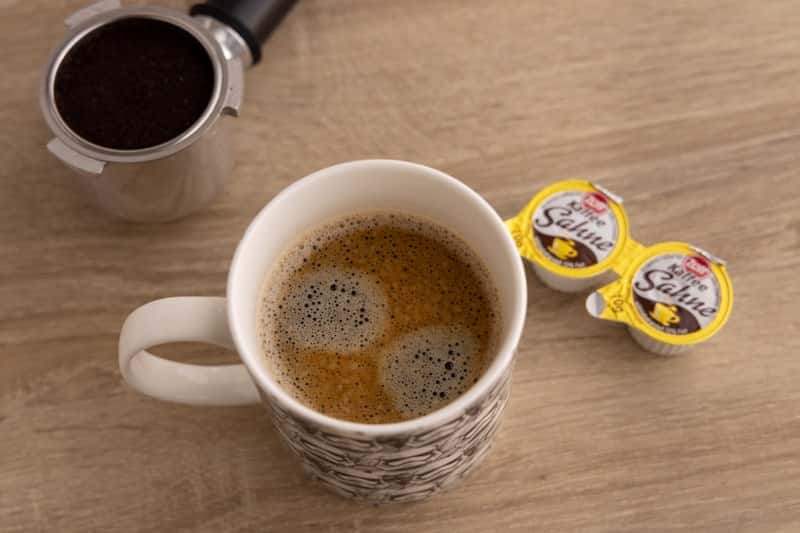This article explores the potential health risks of consuming expired coffee creamer. We examine the shelf life of the different types of coffee creamers and the harmful effects of using them past their shelf life. Read on to make the right choice about your expired coffee creamer.
Are you a coffee lover? We've all had that moment when we're enjoying a cup of coffee, but your creamer just won't mix. Then it begins to smell funny and curdled. When this happens, you likely discard the offending item and reach for a new one. Despite expired creamer being bad news, there is a way you can ensure your coffee creamer is still safe for consumption.
What Makes Up Coffee Creamer?
Whether liquid or powdered, coffee creamer adds flavor and texture to coffee or other hot beverages. It is used as an alternative to milk or heavy cream.
Here is a breakdown of some common ingredients found in coffee creamer:
- Sugar: Often the primary ingredient in coffee creamer, sugar adds sweetness to the product. Some creamers may use alternative sweeteners like corn syrup, high fructose corn syrup, or artificial sweeteners.
- Vegetable Oil: Vegetable oil is often used to give the creamer a creamy texture. It may be derived from soybeans, palm, coconut, or other plant sources.
- Sodium Caseinate: This protein derived from milk is often added to coffee creamer to give it a richer, creamier flavor.
- Dipotassium Phosphate: This is an emulsifier that helps to mix oil and water, creating a smooth texture in the creamer.
- Natural and Artificial Flavors: They are added to give the creamer its distinctive flavor. Natural flavors may come from fruits or other food sources, while artificial flavors are typically created in a lab.
- Coloring: Some creamers may contain artificial coloring to give it a consistent color and appearance.
Not all coffee creamers are created equal, and some may contain additional ingredients or have different proportions of the above ingredients. Reading the label carefully to understand what you're consuming is always a good idea.
Coffee Creamer Expiration Dates

The shelf life of coffee creamer can vary depending on the type of creamer.
1. Dairy creamer typically has a shorter shelf life than non-dairy creamer and should be used within a week or two of opening, especially if it's not stored in the refrigerator.
Past expiration: It's generally not recommended to use dairy creamer past the expiration date as it can spoil and cause foodborne illness. If it's unopened but kept in the fridge, it may last 1-2 weeks past the expiration date but no more than 10 days if opened.
2. Non-dairy creamers, such as those made from soy or almond milk, generally have a longer shelf life than dairy creamer. It can last up to a month in the refrigerator after opening, but you should judge based on its appearance, smell, and taste.
Past expiration: They can usually be used longer past the expiration date than dairy creamer, as long as it has been appropriately stored in the refrigerator and shows no signs of spoilage, such as a sour smell or off-taste. Use your judgment and senses to determine if it's still safe, but it typically lasts up to one month past the expiration date.
3. Powdered creamer usually has a longer shelf life than liquid creamers. An unopened container of powdered creamer can last up to two years or more in a cool, dry place. Once opened, it's best to use it within six months to a year.
Past expiration: It can also last for some time past the expiration date. However, the quality and taste of the creamer may decline over time. Use it within six months and check for any signs of spoilage before using it.
Health Risks Associated with Expired Coffee Creamer

Expired coffee creamer can pose health risks due to the potential for bacteria and mold growth.
Bacteria can grow in the creamer as it ages, especially if not stored properly. Consumption of bacteria-contaminated creamer can lead to foodborne illness, with symptoms such as:
- Diarrhea
- Vomiting
- Abdominal cramps
- Fever
Mold growth can also occur in expired coffee creamer, especially if exposed to air or moisture. Consumption of mold-contaminated creamer can cause some people allergic reactions or respiratory problems.
Ways to Ensure Your Coffee Creamer is Stored Properly

Proper storage of coffee creamer is essential to maintain its freshness and flavor. By following these storage tips, you can ensure that your coffee creamer is safe to consume and reduce the risk of developing foodborne illnesses.
- Keep your coffee creamer in a cool and dry place. Move it away from direct sunlight and heat sources like ovens, stovetops, or radiators. The ideal temperature for storing coffee creamer is between 32°F and 40°F.
- Always keep your coffee creamer container tightly sealed when not in use. This will prevent air and moisture from getting in and prolong the shelf life of your creamer.
- Once you open your coffee creamer container, make sure to refrigerate it. It will help maintain freshness and prevent the growth of bacteria.
- Use a clean spoon or a dedicated utensil to scoop out your creamer instead of dipping your fingers or using a dirty utensil. It will go a long way to prevent contamination and extend the shelf life of your creamer.
Conclusion
It is possible that expired coffee creamer can make you sick. Over time, the creamer may develop harmful bacteria, such as Listeria monocytogenes, Salmonella, or E. coli, which can cause food poisoning. These bacteria can cause a range of symptoms, from mild stomach discomfort to severe illness.
Check the expiration date on your coffee creamer and discard any that have passed it. If the creamer has an unusual smell, appearance, or taste, it is best to err on the side of caution and throw it away. Additionally, always store your creamer in the refrigerator and use a clean spoon each time you scoop it out to avoid contamination.